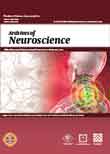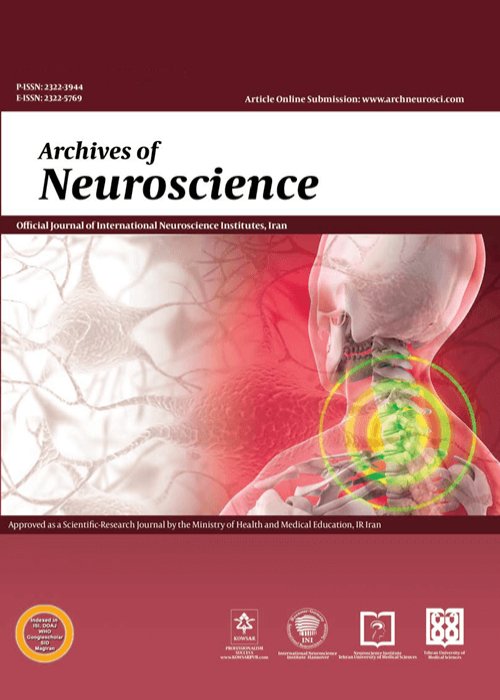فهرست مطالب

Archives of Neuroscience
Volume:4 Issue: 3, Jul 2017
- تاریخ انتشار: 1396/04/30
- تعداد عناوین: 10
-
-
Page 1Context: Deregulations of the bodily systems increase the predisposition to cerebrovascular diseases (CVDs). Thyroid hormone deregulations lead to an observed increase in predisposing such patients to stroke.
Evidence Acquisition: Online literature search was conducted using PubMed, Google Scholar, and Cochrane as databases.ResultsIncrease in thyroid hormone level affects the cardiovascular system by increasing the density of beta-adrenergic receptors on cardiomyocytes. The highest post diagnosis risk in hyperthyroidism has been reported for atrial fibrillation and arterial embolism, which increases the risk of ischemic and nonischemic stroke. Atrial fibrillation has thromboembolic stroke as one of the feared outcomes.ConclusionsPreexisting literature has considerable evidence of increased risk of CVDs in patients with hyperthyroidism and atrial fibrillation together, compared with patients who have either of these diseases.Keywords: Atrial Fibrillation, Hyperthyroidism, Stroke, Cerebrovascular -
Page 2Sleep is an important factor in memory consolidation and brain health. In addition, sleep disorder is a common complaint among females in comparison with males. In menopausal females, to relieve sleep disturbances and other menopausal symptoms, hormone therapy may be used. Furthermore, although estrogen had helpful effects on the brain performance, hormone replacement therapy augmented unfavorable cardiovascular and oncological side effects. It is implied that exercise is a powerful non-pharmacological intervention that can develop the cognitive performances. The current study used the behavioral, physiological, and molecular evidence supporting these views.Keywords: Sleep Deprivation, Physical Exercise, Cognitive Function, Female Rat
-
Page 3Mindfulness meditation and mindfulness-based interventions offer numerous clinical benefits related to improved affect regulation and emotional functioning. Psychological and emotional benefits of dispositional mindfulness, conceptualized as an individual difference trait found among the meditation-naïve, also have been demonstrated. This literature review article describes five specific research investigations examining potential neurocognitive emotion regulation mechanisms associated with dispositional mindfulness. Higher dispositional mindfulness may allow for enhanced top-down prefrontal control of limbic activity when coping with negative emotional stimuli, and individuals with greater trait mindfulness also may experience lower levels of neural activity in response to such stimuli. These patterns of improved affect regulation with increased dispositional mindfulness may reflect lower resting activity in key brain areas such as the amygdala.Keywords: Mindfulness, Emotions, Cognition, Neurosciences
-
Page 4BackgroundThe health care sector constitutes one of the largest sources of employment worldwide.ObjectiveThe aim of this study was to describe the psychosocial status of health care workers and its association with different covariates.MethodsHealth care workers from different universities, hospitals, clinics, urban and rural health centers took part in this cross-sectional study. The medium version of COPSOQ was used to evaluate the association between COPSOQ and covariates. The multivariate analyses of variance and covariance were employed to determine multivariate and univariate associations between all psychosocial dimensions and covariates.ResultsMost COPSOQ scores showed a good internal consistency and reliability, with total Cronbachs alpha of 0.76. The study population comprised 7,027 health care workers among whom 64% were female. The results indicated that nurses are more exposed to the psychosocial work environment compared to the other groups of workers within the health care settings.ConclusionsNurses had a significantly higher risk regarding almost all the psychosocial factors. Considering that the main shortage of human resources in our study population belonged to the nursing group, this bad situation is not surprising. Healthcare workers, especially nurses, are facing various psychosocial factors more than other workers are, because all these factors are in the healthcare environment at the same time.
-
Page 5BackgroundPain is an unpleasant sensory experience associated with actual or potential tissue damage. In patients with spinal cord injury (SCI), pain may occur as a result of damage to the spinal cord, or it may occur due to damage to other areas of the body at the time of injury. It is also common for many individuals with SCI to experience different types of chronic pain. Sometimes the pain is very severe and may have a great impact on daily living. This study evaluates the prevalence and different types of pain in Iranian SCI patients.MethodsEighty four SCI patients were included in the present study based on an inclusion criteria. An expert physiatrist evaluated the patients and filled demographic questionnaires. After, the patients filled the short-form McGill pain questionnaire (SF-MPQ-2).ResultsThe mean age of patients was 34.9 (SD: 10.9) years and the mean duration of spinal cord injury as well as duration of having pain were 2.57 (SD: 2.32) and 1.81 (SD: 1.96) years, respectively. The most prevalent type of pain was tingling (84.5%), hot-burning and shooting pain (65.7%), as well as cramping pain (63.1%). The mean of pain in the visual analogue scale (VAS) is 5.69 (SD: 2.21).ConclusionsPain is one of the most debilitating complications among SCI patients. Heeding to the patients pain, its appropriate and precise diagnosis, and timely treatment can improve the quality of life as well as their more efficient return to social activities among these patients.Keywords: Spinal Cord Injury, Pain, Neuropathic Pain
-
Page 6BackgroundNowadays, the endoscopic transsphenoidal approach is the initial option for resection of all pituitary adenomas. The current study reported the experience with endoscopic transsphenoidal surgery remission rates using the 2010 consensus criteria, predictors of remission, and the associated complications.MethodsA prospectively collected database of 49 patients with acromegaly who underwent endoscopic endonasal transsphenoidal surgery was analyzed. Tumors were classified according to size, as well as the Knosp and the Hardy-Wilson classifications. Endocrinological remission was defined as normal insulin-like growth factor (IGF)-I level and either a suppressed growth hormone (GH) levelResultsBiochemical remission was achieved in 7 of 9 (77.8%) microadenoma and 28 of 40 (70%) macroadenoma. The total remission rate was 71.4% and gross total resection was achieved in 45 of 49 (91.8%) patients. Tumor size, age, gender, history of prior surgery, suprasellar extension, and sphenoid sinus invasion were not associated with remission rate. Preoperative variables predictive of remission included the Knosp score (P = 0.041) and GH levels (P = 0.047). Two patients (4.1%) experienced postoperative pan hypopituitarism, and permanent DI was observed in 3 (6.1%) patients. One patient (2%) had cerebrospinal fluid (CSF) leaks treated with serial lumbar punctures. The median follow-up period was 25.45 months; ranged from 3 to 49.ConclusionsEndoscopic transsphenoidal adenoma resection leads to a high rate of endocrinological remission in patients with low acromegaly complication. Patients with high preoperative GH levels and the Knosp scores are less likely to achieve remission.Keywords: Acromegaly, Endoscopy, Growth Hormone, Pituitary Adenoma, Skull Base
-
Page 7BackgroundIntroduction of the novel imaging modalities such as optical coherence tomography and scanning laser optical tomography allow the morphological and functional evaluation of the intracochlear structures up to the histological details. The prerequisite of these modalities is the preparation of the membranous labyrinth by removing the dense otic capsule to enhance the optical penetration depth. In the present study, a combination of the chemical decalcification and bone drilling method was explained for the preparation of the human inner ear structures for further studies.MethodsIn this study, nine human temporal bones were used and trimmed in cubes containing middle and inner ear structures. The samples were immersed in 5% nitric acid, 20% EDTA, and 10% EDTA solutions, respectively. The samples were brought out and rinsed every 90 minutes, and mechanical removal of the softened bone was performed with surgical drill system until the complete decalcification of the samples was confirmed by X-ray imaging. The prepared samples were evaluated by microcomputed tomography imaging for anatomical distortions caused by the preparation process.ResultsComplete decalcification and preparation of the samples were obtained in average of 10.5 ± 0.5 hours. No obvious morphological changes were observed in microcomputed tomography images, except for fracture of the remnant bony shell at the apex of cochlea in one sample.ConclusionsThe combination of the chemical decalcification and mechanical removal of the softened bone can accelerate the sample preparation for high resolution imaging studies without significant morphological changes.Keywords: Temporal Bone, Inner Ear Anatomy, Decalcification, Cochlea, High Resolution Imaging
-
Page 8IntroductionAnterocollis was described in the Parkinsons disease and was often indicated as responding well to levodopa therapy. This article, on the other side, investigates the case of a patient with anterocollis whose condition worsened because of the levodopa therapy.Case PresentationA man suffering from Parkinsons disease since the age of 63 years began presenting a subacute appearance of anterocollis at the age of 73 years. Clonazepam, botulinum toxin, and physiotherapy relieved the pain without improving the anterocollis, while the suspension of both pramipexole and domperidone proved ineffective. The washout of the levodopa for 12 hours caused a worsening of the PD but an improvement of anterocollis. All attempts to increase the posology of the levodopa led to an improvement of the PD but worsening of the anterocollis.ConclusionsUsually the anterocollis improves with levodopa, but in rare patients, levodopa therapy causes worsening of the anterocollis despite the improvement of rigidity.Keywords: Anterocollis, Levodopa, Parkinson's Disease, Side Effect
-
Page 9Microarchitecture of thalamic inputs suggests that the main information that reaches the cortex trans-thalamically contains copies of motor instructions issued to lower motor centers in the central nervous system. This includes all sensory inputs that reach the cortex with the sole exception of olfaction. Moreover, all cortical areas, regardless of their classification as sensory, motor or associational, contain layer VB neurons that have branching axons that innervate both lower motor centers in the CNS and thalamic relays. These findings together challenge the sensory versus motor dichotomy within the thalamus and the cortex and suggest that all thalamocortical interactions are to some extent both, sensory and motor. This means that agency and perception are inseparable. All experience is, therefore, necessarily a model for an agent. An important feature of all models is that they have outside requirements to function as such. They are not ends in themselves. The necessary background for a model can be provided by other more basic models, which is something that contemporary science has done very successfully. However, science, which is itself a model, ultimately requires the existence of something that is unmodelable. Therefore, being a scientist and believing in God is not contradictory.Keywords: Thalamus, Perception, Efference Copies, Modelability, Theology


